MySurvivalPack Core PUK Micro Stove

The Core PUK Micro Stove is a fuel-efficient alcohol stove with a titanium base for stability and a titanium pot stand for ease of use. Easy to set up and use, this stove offers a two-phase burn (boil and simmer) in a lightweight, compact kit—perfect for solo treks or trips with a friend. It can boil 2 cups of water fairly quickly and then continue burning up to 15-20 minutes on 1 oz/30 ml of fuel.
Pros
- Thrifty fuel consumption
- Lid allows unused fuel to be saved
- Stable titanium base
- Lightweight titanium pot stand included
- Can be used with a wide array of ultralight pots
Cons
- Adversely affected by wind
- A bit pricey for an alcohol stove
A few months ago, idly browsing the web, I came across a Kickstarter campaign for a new alcohol stove. Being a stove junkie, I read further, intrigued but skeptical as I read some of the claims. What was being marketed was an ultralight alcohol stove system with automatic simmer phase and a claimed 2 cup boil time of 4 minutes, 30 seconds. At $27, I bit, as did enough others that the campaign was a success, and one afternoon this past winter I found a package in my mailbox containing the stove and other assorted goodies.
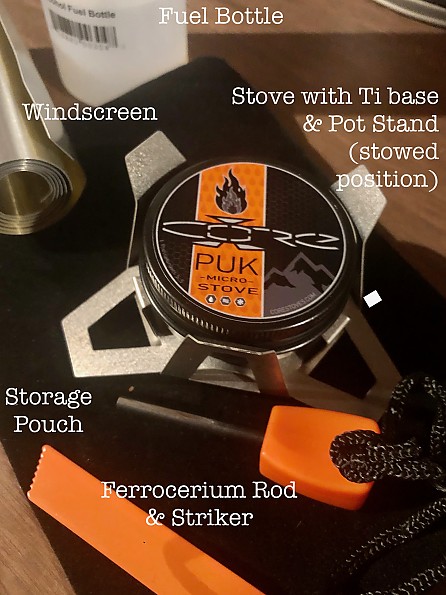 The stove is called the Core PUK Micro Stove, and my $27 pledge got me what designer Chad Mueller billed as the Core PUK Ultimate Stove Kit. In the wording from the campaign, this consisted of
The stove is called the Core PUK Micro Stove, and my $27 pledge got me what designer Chad Mueller billed as the Core PUK Ultimate Stove Kit. In the wording from the campaign, this consisted of
-
1 Core PUK Micro Stove System w/Auto-Simmer
-
1 Mini Firesteel
-
1 2oz Fuel Bottle
-
1 4x4 Carbon Felt Pot Grabber
Incentives being a part of Kickstarter campaigns, that same pledge eventually also included a heavy duty windscreen, a storage pouch, and an ultralight folding knife—nothing of extraordinary quality but fun little incentives.
Post-Kickstarter pricing is $27 for the stove, base, and pot stand. The fuel bottle adds $1, as does the pot grabber, while the fire steel adds $1.50, or $30.50 for the “Core PUK Ultimate Stove Kit” I received.
Components of the Kit
Let me walk you through the components of this kit.
The stove itself comes in a round, lightweight aluminum tin with a white gasket in the lid to seal in fuel. It measures 2.17 in/55.4 mm in diameter at the widest and .84 in/21.5 mm tall. The interior consists of an outer black wick (evidently of carbon felt), a thin-walled fuel reservoir (it appears to be akin to the aluminum cups votive candles sometimes come in), and a white inner wick. Tolerances were nice and tight; cut edges of the wick were sharp upon arrival. Included were both a base and a pot stand (pictured above). The titanium pot stand is 2.29 in/58.3 mm wide while the titanium base is 3.75 in/95 mm wide. The base clips onto the bottom of the stove, with three clips pressing into the sides of the stove to secure the base when weight is placed on the stove. The pot stand simply fits inside the rim of the stove tin. The fits of base and pot stand are snug and inspire confidence that the stove won’t come apart during use.
Included were both a base and a pot stand (pictured above). The titanium pot stand is 2.29 in/58.3 mm wide while the titanium base is 3.75 in/95 mm wide. The base clips onto the bottom of the stove, with three clips pressing into the sides of the stove to secure the base when weight is placed on the stove. The pot stand simply fits inside the rim of the stove tin. The fits of base and pot stand are snug and inspire confidence that the stove won’t come apart during use.
With the parts attached to the stove, the Core PUK Micro is 2.37 in/60.3 mm tall. Fit and finish of titanium pieces were decent: I could see where there were remnants of sharp attachment points on the titanium from its manufacturing process, but these were merely aesthetic considerations, something that could be remedied with a file should I care to do so.
The mini-fire steel is a perfectly serviceable tool, seemingly of the sort that comes with many different kinds of stove and fire kits and which could have been mass-produced abroad. It throws an adequate spray of sparks that can readily ignite the stove (of fire tinder, for that matter). The ferrocerium rod itself has a plastic handle and a lanyard attaching it to the striker. The striker is painted and has a sharp right-angle edge that readily throws sparks from the rod when scraped against it. The rod measures 5/32 in/ 4.15 mm in diameter with a usable length of 1.58 in/40 m and an overall length of 2.67 in/ 68 mm. With lanyard and striker, it weighs .5 oz/14 g.
The 3.88 in/98.5 mm tall fuel bottle, with a 2 oz/60 ml capacity, is made of type 2 HDPE. The black flip top seals securely enough to prevent leaks and allows for easy and accurate squirting of fuel into the stove. This is a great size fuel bottle for an overnighter, providing as it does about 35-40 minutes of stove use. A larger bottle would be required for longer treks.
The pot grabber is a square of what is evidently the same sort of material from which the black wicks are made. It is a bit thinner, though, and bears a striking resemblance to parts of other stove kits the designer has assembled, where similar items are billed as “carbon felt heat shield/spill catch” and “carbon felt snowshoe.” It weighs .22 oz/6 g and measures 4x4 in/10.2 x 10.2 cm. It is .16 in/4.2 mm thick, a thickness that lends it to pot-grabbing duties.
Testing: In the Field and in the Workshop
Prior to the Covid-19 pandemic descending upon my region, I took the Core PUK Micro on a number of backpacking trips, using it to boil water for dehydrated meals and coffee. 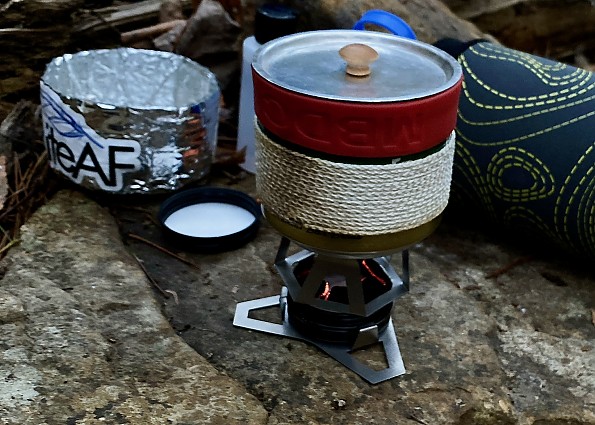 Once the pandemic arrived, I’ve used it in my backyard for boiling water for coffee (coffee is a daily ritual for me) and a little cooking. I’ve also run a series of tests on it in my (ventilated) shop under controlled conditions as well as in my backyard on a spring day with consistently gusty 13 mph winds.
Once the pandemic arrived, I’ve used it in my backyard for boiling water for coffee (coffee is a daily ritual for me) and a little cooking. I’ve also run a series of tests on it in my (ventilated) shop under controlled conditions as well as in my backyard on a spring day with consistently gusty 13 mph winds.
 I ran nine tests to measure speed-to-boil and total burn time on 1 oz of fuel and then four tests to measure fuel consumption. All were run across a range of configurations of different pot materials, windscreen or no windscreen, different pots and pot diameters, etc. A sampling of tests appears below; please feel free to ask me about my tests in the comments below should you have any questions. While I could not isolate all the variables affecting stove performance in scientific fashion, trends emerged that I will discuss later.
I ran nine tests to measure speed-to-boil and total burn time on 1 oz of fuel and then four tests to measure fuel consumption. All were run across a range of configurations of different pot materials, windscreen or no windscreen, different pots and pot diameters, etc. A sampling of tests appears below; please feel free to ask me about my tests in the comments below should you have any questions. While I could not isolate all the variables affecting stove performance in scientific fashion, trends emerged that I will discuss later.
 Below is a video that provides an overview of the Core PUK Micro as well as sped-up footage of a complete burn demonstrating the boil and simmer phases of the stove.
Below is a video that provides an overview of the Core PUK Micro as well as sped-up footage of a complete burn demonstrating the boil and simmer phases of the stove.
Now let’s examine the designer’s claims about the Core PUK Micro.
Addressing the Maker’s Claims
The designer lists a series of claims and characteristics on his web page, so I’m going to address these claims (recorded below, verbatim, in italics) in the order in which they appear.
-
“The complete stove system weighs under 1 ounce at only 25 grams!” This is close. Perhaps my scale is inexact or maybe the stove retained vestigial fuel after a test, but I measured 7g for the base, 7g for the pot stand, and 14g for the empty stove for a total of 28g/ .99 oz. That’s more than the designer’s claim, but still under an ounce. Without the stove lid, the base + the pot stand + the lidless stove weighed 24 g on my scale.
-
“It can boil 2 cups of water in only 4:35 seconds and then Auto-Simmer for another 15 *additional* minutes... with only 1 oz of fuel!” I assume, first of all, that that’s 4 minutes, 35 seconds, not 4.35 seconds! My tests could not equal this impressively fast boil time.
-
I did find that 16-20 minutes was the consistent burn-time range for 1 oz/ 30 ml of fuel, which is quite efficient, but I could never duplicate that claimed time. My fastest boil came at 5:20 with my thinnest, widest-bottom Ti pot while burning Jasco Denatured Alcohol (as in all of my tests).
-
Different pot materials didn’t seem to make a huge difference--the thinness of my titanium pots yielded better boil times than the thicker walls of my similarly sized aluminum pots. Wider pot diameter combined with thinner pot walls seem to improve efficiency of the stove--my 1.3L Evernew logged two of the fastest, most efficient boils.
-
Jasco Denatured Alcohol is a mix of ethanol and methanol and a few nasty ingredients, and it doesn’t burn as hot as pure ethanol. That fuel (e.g., Everclear 190 proof) is illegal in my home state, so I was unable to test with it. I should note, though, that the web page lists Denatured alcohol and yellow HEET as the stove’s fuels.
-
-
“It's tune-able for a long slow burn or Hot then Auto-Simmer, with no extra parts!” This is sort of true. This claim—and the speedy boil time above—is based on the stove’s wick design: the outer black wick tends to lean in, so if it were to be fully opened (“tuned,” in the language of the designer), it could distribute the flame over more of the pot’s bottom. Here is how the open and closed wicks look on the designer’s page:
 However, in my experience, once that outer wick has been used and especially if it is wet with fuel, it doesn’t stand as far “open” as pictured on the website. This is what it looks like when opened after quite a bit of use.
However, in my experience, once that outer wick has been used and especially if it is wet with fuel, it doesn’t stand as far “open” as pictured on the website. This is what it looks like when opened after quite a bit of use.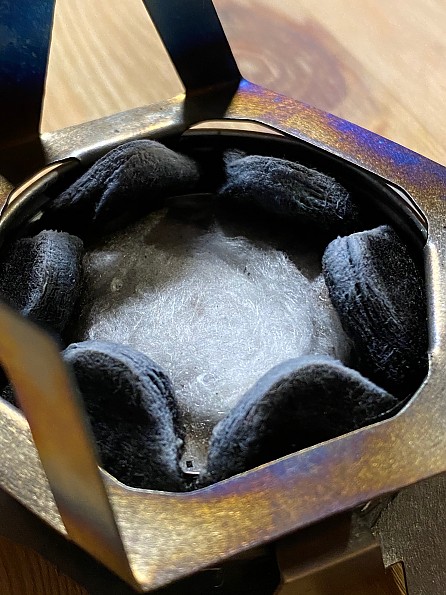 The degradation of the wick seen in the picture above is apparently normal. The website notes that the stove’s wick will erode “after many uses,” further noting that “you might notice your boil times getting better as the wick is shorter. Time will tell; the stove did come with an outer black replacement wick.
The degradation of the wick seen in the picture above is apparently normal. The website notes that the stove’s wick will erode “after many uses,” further noting that “you might notice your boil times getting better as the wick is shorter. Time will tell; the stove did come with an outer black replacement wick.As the fuel chamber for the outer wick is exhausted, the Core PUK Micro does indeed switch over to simmer mode, at that point consuming the fuel soaked in the white inner wick while the now fuel-depleted outer wick petals serve to aim the flames inward.
The designer claims “~6-7 minutes” for the boil phase, and then “~15 more minutes” for simmer. I somewhat arbitrarily decided the simmer mode begins when the flames no longer curl up the sides of the pot and the black wick, exhausted of fuel, begins to glow orange at its tips as the flame shrinks and migrates closer to the center of the pot—in other words, when the fuel source for the outer, hotter-burning wick is used up.
My own data showed a longer boil phase generally extending to the 9:30-11:00 minute mark, and about a 5-9 minute simmer phase. Temperature drop of the water—just water—only occurred during the last :30 seconds or minute of the flame’s life, when it was no longer sufficient to keep the simmer going at a steady temperature.
Because the stove is efficient, it can still be a bit of a challenge to simmer starchy foods. I tested the simmer mode by cooking grits (it’s a Southern U.S. thing, y’all), the directions for which require simmering for 15-20 minutes.
 The one cup of water required for the grits boiled quickly. I added the grits, but their volume wasn’t sufficient to drop the temperature in the pot significantly because the stove was still in the boil phase and was therefore a bit too hot to slowly simmer the grits. I poked down the black outer wick as best I could to encourage simmer mode, but ultimately resorted to frequent stirring and doing something I generally do on the trail anyway—I pulled the pot off the heat to finish cooking with carryover heat and blew out the stove. It cooked the grits fine, and faster than expected.
The one cup of water required for the grits boiled quickly. I added the grits, but their volume wasn’t sufficient to drop the temperature in the pot significantly because the stove was still in the boil phase and was therefore a bit too hot to slowly simmer the grits. I poked down the black outer wick as best I could to encourage simmer mode, but ultimately resorted to frequent stirring and doing something I generally do on the trail anyway—I pulled the pot off the heat to finish cooking with carryover heat and blew out the stove. It cooked the grits fine, and faster than expected.
-
“It's got a lid! So fill it up before you go, and save the left over fuel when you're done!” Yes, that’s true, and it means you can carry more fuel than just the full fuel bottle with you. Just heed the warning not to close it while warm and vacuum seal it shut forever after as it cools.
-
“It's stable and can be used with or without the optional stabilizing foot.” Yes, that’s true as long as you have an absolutely level surface to cook on. But why quibble over an additional 7g of something that can inspire a bit more confidence in its stability? The base can be adjusted for a more uneven surface, so just take the base with you.
-
“It's compact and efficient; all parts snap together for easy storage in your pot!” Yes, that’s true, depending on the pot size, of course. The sprawl of the base can occupy more than its fair share of space in a small pot, but the entire kit fits nicely inside a handkerchief in my IMUSA pot.
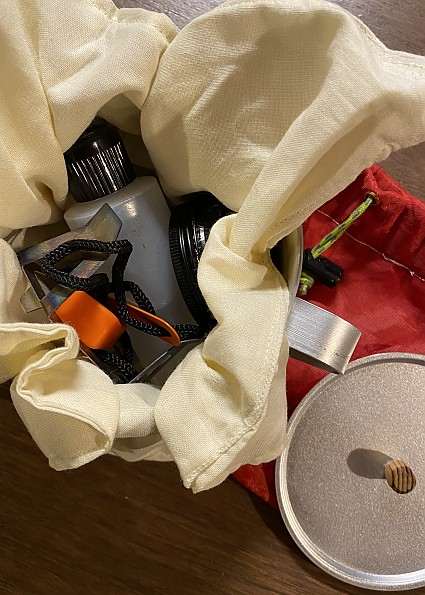
-
“The fuel it burns is cheap and you can get it at any gas station or hardware store!” This, too, is true: alcohol is among the most readily available fuels. Even yellow-bottle HEET works, and it can be had for very little money.
-
“It's small enough that when you're done cooking, you can just blow it out!” Yes, this is true. Be careful, naturally, but assuming you’re not blowing it out with liquid fuel pooling atop the wick material just after refueling, this can be done in safe fashion to save leftover fuel.
-
“It works with any pot or pan so you're not just stuck to just one proprietary pot!” The proprietary pot issue is the bane of some stove systems, and it is true you can use a wide variety of poets with this stove.
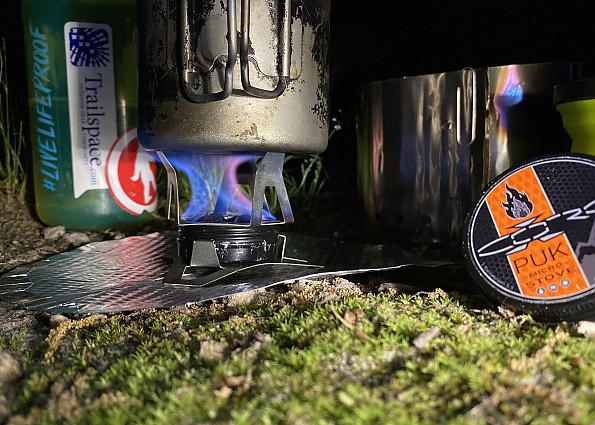 Unlike my Caldera Cone, which is designed and optimized to fit a single pot, I have an array of pot choices with the Core PUK Micro—in my testing, from 550 ml to 1.3L. This means that the stove can readily accommodate the cooking needs of one or two people. There are a few caveats, however. While the stove system had no problem holding any of the pots I tested with a pound of water in them, the Ti pot support is springy and light; it obviously isn’t designed to hold a monster pot or cast iron beast or the like. The instructions indicated that it is intended “for use with ultralight pots and pans.” So perhaps it is better to say any reasonable ultralight pot.
Unlike my Caldera Cone, which is designed and optimized to fit a single pot, I have an array of pot choices with the Core PUK Micro—in my testing, from 550 ml to 1.3L. This means that the stove can readily accommodate the cooking needs of one or two people. There are a few caveats, however. While the stove system had no problem holding any of the pots I tested with a pound of water in them, the Ti pot support is springy and light; it obviously isn’t designed to hold a monster pot or cast iron beast or the like. The instructions indicated that it is intended “for use with ultralight pots and pans.” So perhaps it is better to say any reasonable ultralight pot. -
“It's made from titanium so it's tough and dependable and will practically never wear out!” While elsewhere on the website the materials are listed as titanium and aluminum, this bullet could be a bit misleading: the stove base and pot stand are indeed made of titanium, but the stove container itself is aluminum, and therefore more subject to scratching, denting, etc. Mine looks pretty shop-worn now, but that aluminum also keeps the price down.
-
“It's Made in the USA and Finished and Formed by Hand!” I know that the designer and his crew did hand-bend and assemble all of the stoves from the Kickstarter project (we received updates about sore hands!). I don’t know if the materials themselves were sourced in the USA or not—the website says, "Core Stoves are made in North Idaho, branded and finished by hand. All parts are made in the U.S.A." I have a strong suspicion that the fire steel and fuel bottle as well as some of the freebies came from abroad, though.
With the maker's claims examined, let's look at a few more basic points about the stove.
Observations
Quality: The stove base and pot stand are springy, responsive titanium. The material seems to be of decent quality: it can be bent by hand, allowing one to adjust the base for uneven surfaces, but it is sufficiently strong to hold its shape and doesn’t appear to have been stressed by minor bending to level the stove. The stove container is lightweight aluminum: it acquires dents and scratches easily, acquiring cosmetic blemishes that do not affect its effectiveness as a stove. Overall, there isn't much that could go wrong with this stove because of its simplicity.
Setup and Use: It is easy to set up, requiring nothing more fancy than pressing the stove into the base, unscrewing the stove’s lid, and then pressing the pot stand into the top of the stove. A squirt of a fuel bottle and a spark or flame and the stove is up and running. Mittened hands in winter could still negotiate this, although properly seating the stove in the base and the stand into the stove might prove increasingly challenging if the cold impaired manual dexterity.
Stability: Unlike some alcohol stoves, the Core PUK Micro comes with a base. When weight bears down on the stove, the base grips the stove more securely. The Ti pot stand has a springy feel to it but also a low profile which helps to discourage tippiness. The stove requires a reasonable measure of care when placing a full pot on the stand, but there is no real balancing act required, nor does a pot on the stove feel particularly precarious once it is placed. I will note, though, that I am generally careful about placing any pot on any stove.
Fuel: It burns alcohol, which is readily available in various places globally, and it typically uses this fuel sparingly. The lid also means you can save unused fuel after reaching a boil. Weight: This is a lightweight setup. Total system weight with a windscreen and fuel is 4 oz/ 113 g—that’s base, pot stand, stove with lid, ferrocerium fire starter with striker, fuel bottle with 2 oz/ 60 ml of fuel, and a Ti windscreen. Nestled in, say, an IMUSA cup (700 ml Al) with lid, you’re looking at 7.4 oz/ 209 g for a cook kit with about 40 minutes of fuel.
Weight: This is a lightweight setup. Total system weight with a windscreen and fuel is 4 oz/ 113 g—that’s base, pot stand, stove with lid, ferrocerium fire starter with striker, fuel bottle with 2 oz/ 60 ml of fuel, and a Ti windscreen. Nestled in, say, an IMUSA cup (700 ml Al) with lid, you’re looking at 7.4 oz/ 209 g for a cook kit with about 40 minutes of fuel.
Performance: In terms of performance, a few things stood out to me:
-
Choice of pots (materials and size): this stove works most efficiently with wider-bottomed, thin-walled Ti pots. I tried a slew of pots in different sizes and materials, but wider bottoms and thi walls was the way to go for fast, efficient boils.
-
With a Windscreen: the stove is most efficient when used with a close-fitting windscreen that nevertheless provides plenty of opportunity for oxygen for combustion—in other words, lots of air, but little disruption from wind. The fastest and most efficient time to boil (5:20) occurred when I used the widest, thinnest walled pot with the most secure windscreen in gusty conditions that forced oxygen into the windscreen. Indoors, this same setup without benefit of the wind forcing oxygen to the flame was almost 10% less efficient, yet it still produced one of the best set-ups, yielding a boil in 5:27. Bottom line: use a windscreen, but play with it for optimal performance, balancing protection and access to plenty of oxygen.
-
Without adequate Windscreen: alcohol stoves are generally very susceptible to losing efficiency and power to wind. The Core PUK Micro is no exception. On the same day and in the same wind that I logged the fastest, most efficient boil, I also logged the stove’s most abysmal performance: a 12-minute slog that used most of the 1 oz of fuel to reach a boil. However, this test was conducted on a slotted table top without a heat shield to block the wind swirling beneath the stove and with a windscreen that was probably too big to adequately shelter it from the sides, too. I could hear the wind whipping the flames about as it gusted under and over the stove. Don't forget to add a windscreen to this kit!
-
Simmer Mode: For me, part of the appeal of this stove centered on the dual-fuel reservoir/dual-wick design that provides both a relatively quick boil time and a more efficient simmer. This simmer function built into the Core PUK Micro’s design is theoretically “tunable,” but in my own experience, I found the tunability of the stove to be somewhat limited (see grits example described above). However, it was also not something I was particularly inclined to worry about, either, since I usually blew out the stove to conserve fuel and rehydrated my food in a cozy. Still, with bulkier food fare capable of stalling a boil when it is added to the water—think of a mass of pasta being added to boiling water—the simmer feature is nice to have to lengthen the time that you can heat food.
A Word on Competition: While the Core PUK Micro provides a hot boil and a relatively long simmer, the field for lightweight, cottage industry alcohol stoves offers ample competition, notably with the Trail Designs Kojin—see Flip NC’s excellent review of that stove here—and Zelph’s Modified Starlyte stove (reviewed here by JRinGeorgia).
The Core PUK Micro is slightly more complicated and more expensive than either of those stoves, but it also comes with a stable Ti base and a lightweight Ti pot stand. Its simmer mode also distinguishes it from the Kojin, which doesn’t have this option, or the Modified Starlyte, which has a stainless simmer ring built into it which, to my understanding, is not really designed to be removed. This simmer feature will be most attractive to those whose foods require some on-stove simmering to rehydrate.
As its designer notes, the Core PUK Micro can also be used with a variety of pot and windscreen combinations. This is not that the Kojin or Starlyte couldn’t be used in this manner, too, but the Trail Designs page notes that the Kojin “is intended to be used primarily with the Caldera/Ti-Tri systems” while the Starlyte’s page notes that it’s “[g]reat for use with cone shaped windscreen/pot supports.” The Core PUK Micro, then, appears to have been conceived for greater standalone self-sufficiency with a wider array of pot options in mind.
Conclusion
At $27, the Core PUK Micro customer is buying convenience as well as a lightweight, efficient little stove: other competitor’s stoves are less expensive but don’t come with the Ti base and stand. You’d be hard-pressed to find an equally effective, lighter base and stand than the ones provided with this simple, reliable, and easy-to-use stove.
While the Core PUK Micro kit may not offer the carefully calibrated efficiency of a Caldera Cone system, it does over greater versatility in terms of choices of pots and windscreens, allowing the user to use the stove with various kits for various purposes, from solo trips to tandem treks.
I didn’t get the stove to match the maker's claimed boil time, but the Core PUK Micro readily boils water in the 5:30-7 minute range while also providing progressively more stingy fuel consumption during the simmer phase that stretches the burn time to 16-20 minutes. Some alcohol stove users want the quickest boil, others want the greatest fuel efficiency. This stove offers a pretty compelling sweet spot between both extremes.
Ultimately, then, the Core PUK Micro would be a good choice for someone seeking the convenience and utility of an efficient, pre-made alcohol stove. It offers acceptably fast boil times and admirably long burns with the versatility of being used with different pots. If you're in the market for a simple and reliable alcohol stove, the Core PUK Micro is worth a look.
Background
I've been using the Core PUK Micro for the past few months on both backcountry treks and in my yard during Covid-19 shelter-in-place mandates. I've used it in chilly winter and blustery spring conditions. I've been making, buying, and using alcohol stoves for more than a decade.
Source: Kickstarter Campaign
Your Review
Where to Buy
You May Like
Specs
| Price |
MSRP: $27.00 |
| Fuel |
Denatured Alcohol or Heet |
| Weight |
25 g |
| Material |
Titanium and Aluminum |
| Total Burn Time with 1 oz of fuel |
High ~6-7 minutes, then Auto-Simmer ~15 more minutes |
| Storage Configuration Dimensions |
3.25 x 3.5 x 1.5 in |



